John Hurrell – 13 August, 2010
There is an odd humour in the title work with its calculated gaps in the weave, protruding nylon cable ties that hold the ripples of cable in formation but which also catch the light as a delicate hairy coat in darkness, and its slowly pulsing fiery shapes. Perhaps the fencing is a symbol for the protective barriers around the art world itself, futile defenses on the perimeter of the ‘art compound'.
Eddie Clemens is a Christchurch artist well known for his hi-tech witty sculptures that are often kinetic. He was the 2008 Olivia-Spencer Bower artist-in-residence, the 2009 Frances Hodgkins Fellow, an important contributor to Te Tuhi’s Modern Physics show last year, and most recently in the Heather Galbraith curated Ready to Roll survey at City Gallery in Wellington.
For this Crockford show there are four sorts of work - three of them involving light.
Just inside the door on the opposite wall is a spectacular beech-wood broom with fibre-optic bristles that seem to inhale and exhale changing colours. As the chroma alters it fades as it reaches the wooden base, becoming a tint, and then reintensifies (with gorgeous results) as it springs back to advance towards the fibre-optic tips.
If one craved to put a narrative meaning to the image then it might be a reference to the brooms in Jasper John’s early paintings, or the painting utensils of somebody like Alberto Garcia-Alvarez, the well known teacher and artist in Auckland. Or the story of the sorcerer’s apprentice from Goethe’s poem.
On an adjacent wall is another colourful light work, Delusional Architecture, that is made of woven grey audio cable to look like vandalised sections of Cyclone Fencing. Positioned around the edges of the cut ‘holes’ or snipped ‘tears’ are tiny little orange LEDs, each a minute circuit board with single or double lights. There are six sections of netting positioned in a row, each having an independent timer so that they fade and reglow at different speeds - and also reflect off the white gallery wall at different intensities.
There is an odd humour in this work with its calculated gaps in the weave, protruding nylon cable ties that hold the ripples of cable in formation but which also catch the light as a delicate hairy coat in darkness, and its slowly pulsing fiery shapes. Perhaps the fencing is a symbol for the protective barriers around the art world itself, futile defenses on the perimeter of the ‘art compound’.
The third type of work, again playing with light, uses photographs of supermarket trolleys (with baby holders) taped directly to the wall, with glowing fluorescent tubes projecting out from the wall as trolley handles. The New World images are taken in underground car parks and on the ramps leading up to the shop, and the reflected light of the camera flash in the photo appears to be coming from the real actual fluorescent light. Very clever, spatially intriguing, these often have fluoro tubes on the ceilings in the photographs too, and play on the foreshortened angles of the wire carts and tilted concrete ramps, propelling your eye forward towards the far wall.
The last type of Clemens sculpture is on the floor, champagne bottles jammed into fake metal tissue boxes with fans inside them blowing out air. This moves under soft silk sheets spread out from their mouths, causing waves and ripples to roll across the parquet underneath. Like radar or emitted radio signals from beacons, The Fallen‘s bottles could be talking to each other.
Clemen’s show feels inter-connected with its elements. The throbbing optic-fibre broom bristles repeat the motion of the blowing bottles, the wire grids of the shopping carts mimic the cable grids of Delusional Architecture. It’s the best show I’ve seen of his at Crockford’s. He is really getting into his stride.
John Hurrell
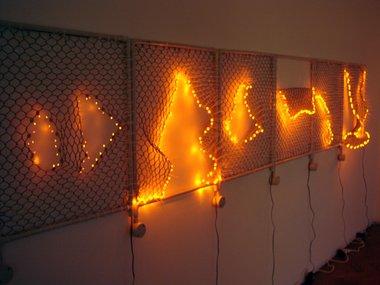


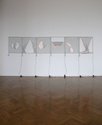
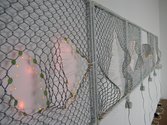
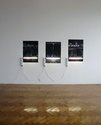
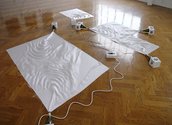
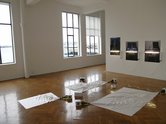
 Two Rooms presents a program of residencies and projects
Two Rooms presents a program of residencies and projects Advertising in this column
Advertising in this column



This Discussion has 0 comments.
Comment
Participate
Register to Participate.
Sign in
Sign in to an existing account.